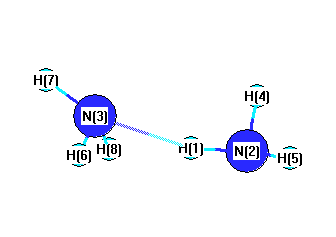Vibrational Frequencies calculated at HF/6-31+G**
| Mode Number |
Symmetry |
Frequency
(cm-1) |
Scaled Frequency
(cm-1) |
IR Intensities
(km mol-1) |
Raman Act
(Å4/u) |
Dep P |
Dep U |
|---|
| 1 |
Ag |
3850 |
3481 |
0.00 |
|
|
|
| 2 |
Ag |
3706 |
3351 |
0.00 |
|
|
|
| 3 |
Ag |
1806 |
1633 |
0.00 |
|
|
|
| 4 |
Ag |
1136 |
1027 |
0.00 |
|
|
|
| 5 |
Ag |
418 |
378 |
0.00 |
|
|
|
| 6 |
Ag |
111 |
100 |
0.00 |
|
|
|
| 7 |
Au |
3856 |
3486 |
11.65 |
|
|
|
| 8 |
Au |
1819 |
1644 |
57.53 |
|
|
|
| 9 |
Au |
218 |
197 |
124.26 |
|
|
|
| 10 |
Au |
73 |
66 |
22.93 |
|
|
|
| 11 |
Bg |
3856 |
3486 |
0.00 |
|
|
|
| 12 |
Bg |
1804 |
1632 |
0.00 |
|
|
|
| 13 |
Bg |
89 |
81 |
0.00 |
|
|
|
| 14 |
Bu |
3851 |
3482 |
40.71 |
|
|
|
| 15 |
Bu |
3708 |
3352 |
7.07 |
|
|
|
| 16 |
Bu |
1792 |
1620 |
48.29 |
|
|
|
| 17 |
Bu |
1106 |
1000 |
541.27 |
|
|
|
| 18 |
Bu |
85i |
76i |
226.48 |
|
|
|
Unscaled Zero Point Vibrational Energy (zpe) 16555.7 cm
-1
Scaled (by 0.9042) Zero Point Vibrational Energy (zpe) 14969.6 cm
-1
See section
III.C.1 List or set vibrational scaling factors
to change the scale factors used here.
See section
III.C.2
Calculate a vibrational scaling factor for a given set of molecules
to determine the least squares best scaling factor.
Charges, Dipole, Quadrupole and Polarizability
Charges from optimized geometry at HF/6-31+G**
Charges (e)
| Number |
Element |
Mulliken |
CHELPG |
AIM |
ESP |
| 1 |
H |
0.327 |
|
|
|
| 2 |
N |
-0.912 |
|
|
|
| 3 |
N |
-0.912 |
|
|
|
| 4 |
H |
0.292 |
|
|
|
| 5 |
H |
0.292 |
|
|
|
| 6 |
H |
0.327 |
|
|
|
| 7 |
H |
0.292 |
|
|
|
| 8 |
H |
0.292 |
|
|
|
Electric dipole moments
Electric dipole components in Debye
(What's a Debye? See section
VII.A.3)
| |
x |
y |
z |
Total |
| |
0.000 |
0.000 |
0.000 |
0.000 |
| CHELPG |
|
|
|
|
| AIM |
|
|
|
|
| ESP |
|
|
|
|
Electric Quadrupole moment
Quadrupole components in D Å
Polarizabilities
Components of the polarizability tensor.
Units are
Å
3 (Angstrom cubed)
Change units.
| |
x |
y |
z |
| x |
0.000 |
0.000 |
0.000 |
| y |
0.000 |
0.000 |
0.000 |
| z |
0.000 |
0.000 |
0.000 |
<r2> (average value of r
2) Å
2
| <r2> |
72.008 |
| (<r2>)1/2 |
8.486 |
